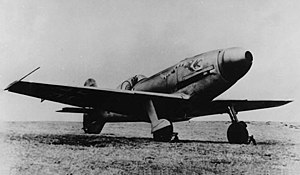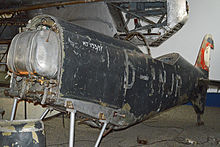Messerschmitt Me 209
| Messerschmitt Me 209 | |
|---|---|
 Messerschmitt Me 209 V4 |
|
| Type: | Fighter plane |
| Design country: | |
| Manufacturer: | |
| First flight: |
August 1, 1938 |
| Number of pieces: |
6th |
Messerschmitt Me 209 is a name for two different aircraft from Messerschmitt AG . The first Me 209 was a pure racing aircraft from 1938 and was renamed the Me 109 R for propaganda reasons . The second version was an unsuccessful further development of the Bf 109 from 1943.
Record aircraft Me 209
The Me 209 was specially designed and built to achieve the absolute world speed record. Design manager was Robert Lussier . The project name was P 1059.
The machine was a single - seat low - wing aircraft with a retractable landing gear and an unusually far rear cabin. The aircraft competed with the Heinkel He 100, which was designed as a fighter aircraft and converted for record-breaking purposes . The first flight of the Me 209 V1 took place on August 1, 1938 in Augsburg-Haunstetten by Hermann Wurster , which showed that the machine was very difficult to fly.
The record-breaking Daimler-Benz DB 601 engines achieved an output of 1325 kW (around 1800 hp), but had a service life of only a few minutes at full power. Up to 2300 hp were available for one minute. A new type of evaporative cooler was used to cool the engine in order to eliminate the air resistance of conventional coolers. However, this cooling used up to nine liters of cooling water per minute. There were 450 liters of coolant on board. A planned surface cooling via the outer skin could not be made operationally safe.
On April 26, 1939, works pilot Fritz Wendel set a new absolute world speed record of 755.138 km / h with the prepared Me 209 V1 (D-INJR). In order to give the public the impression that the machine was a variant of the Luftwaffe's standard fighter, the Messerschmitt Bf 109 , the Propaganda Ministry, headed by Joseph Goebbels , decided to award the record machine to the Fédération Aéronautique Internationale (FAI) "Me 109 R" call. It was not until 30 years later, on August 16, 1969, that a significantly modified F8F-2 Bearcat reached a new record speed of 777 km / h for piston engine-powered aircraft. The record stands today at 850.24 km / h, set on August 21, 1989, also with a modified Grumman Bearcat.
Parts of this first prototype Me 209 V1 are now in the Narodowe Muzeum Lotnictwa in Krakow .
Originally it was actually planned to develop a fighter aircraft based on the type; However, due to the cooling system used, the surface cooling, and the resulting problems such as leaks and distortion of the planking, it was rejected. The use of conventional coolers and the installation of on-board weapons brought the type back into the speed range of existing fighter aircraft. The project was then discontinued.
Me 209 as a further development of the Bf 109
In 1943 Messerschmitt presented a further development of the Bf 109: It was supposed to combine the airframe of the Bf 109G with an enlarged tail unit and wings, a widened landing gear and a more powerful engine. The first prototype, the Me 209 V5, was equipped with a 1900 hp Daimler-Benz DB 603 G and flew for the first time on November 3, 1943. This Me 209 V5 has nothing to do with the Me 209 V1 to V4 that came before Messerschmitt emerged. The number "209" was chosen to give the RLM the impression that it was just another Me 209, not a completely new development, which was hardly approved, but which was the Me 209 V5. But this is exactly what Messerschmitt needed in order to be able to offer a powerful fighter as a successor to the Bf 109 after the failed Me 309 and the uncertain outcome of the engine question of the Me 262. With the Fw 190 D, a competitor to be taken very seriously emerged. The Me 209 V6 got a different engine with the Junkers Jumo 213 E , because the DB 603 was not available in sufficient numbers.
The aim of the further development was to replace the no longer performance-based Bf 109 and Focke-Wulf Fw 190 . Competing products for the Me 209 were the Focke-Wulf Ta 153 design and, above all, the Focke-Wulf Fw 190 D for a short time . Essential criteria were performance data, armament and, above all, a smooth conversion of the manufacturing operations. After a decision to the disadvantage of the Me 209 was made on August 17, 1943, the highest priority for Messerschmitt was given to the Me 262 on October 29, 1943 . After further interventions by both sides, the project was finally stopped on December 14, 1943. A few more tests were only allowed to be carried out with the V5 and V6.
Technical specifications
| Parameter | Data Me 209 V5 |
|---|---|
| crew | a pilot |
| length | 9.24 m |
| span | 10.95 m |
| height | 4.00 m |
| Wing area | 17.2 m² |
| Empty mass | 3339 kg |
| Takeoff mass | 4085 kg |
| drive | 1 × DB 603G , 1397 kW (1900 PS) |
| Top speed | 678 km / h |
| Service ceiling | 11,000 m |
| Range | k. A. |
| Armament | 1 × 30 mm MK 108 cannon, 2 × MG 131 |
literature
- Ferdinand Käsmann: Messerschmitt Me 209. The way to the fastest propeller airplane in the world . Aviatic, Oberhaching 2012, ISBN 978-3-942645-03-4 .
Web links
Individual evidence
- ↑ Manfred Griehl, Joachim Dressel: Focke-Wulf Fw 190 / Ta 152 . Motorbuch Verlag, Stuttgart 1995, ISBN 3-613-01681-8 .



